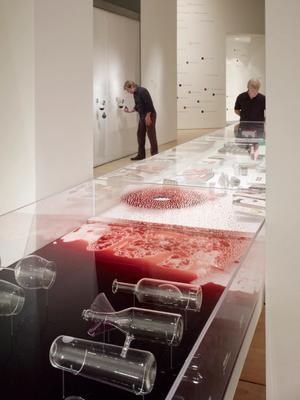
HOWWINEBECAMEMODERN
DESIGN+WINE1976TONOW
How Wine Became Modern: 1976 to Now is the first exhibition to examine contemporary global wine culture through the lens of design. It traces the evolving visual and material culture of wine over three decades and offers a framework for understanding how architecture, graphic design, and industrial design have contributed to the transformation of wine into a modern cultural phenomenon.
The exhibition begins with a photomural reenactment of the so-called Judgment of Paris in 1976, the momentous blind taste test in which nine French wine experts pronounced a number of Northern California wines superior to esteemed French vintages. The event sent shock waves across the globe and gave credibility to the nascent California wine industry, which in turn triggered the expansion of the wine market, popular awareness of wine, the rise of wine criticism, vineyard tourism, and a host of other effects. Informed by archival snapshots of the judges at work, the fictional tableau installed at the entrance to the exhibition is populated by actors cast as look-alikes in period dress and hairstyles. Taking some liberties to insert micronarratives into the scene, the photomural evokes Leonardo da Vinci’s The Last Supper, capturing subtle stories of intrigue in its smallest details and rewarding those who examine it with the curiosity of a detective.
The judge’s table extends through the photomural and into the next gallery, where it becomes a vitrine that deconstructs terroir — the combination of soil, topography, sunlight, and climate that determines a wine’s unique character, taste, and aroma. With viticulture’s expansion across the globe, terroir has become something of a holy grail that winemakers compete for and claim as their own. The installation displays samples from seventeen global vineyards: each is represented by a corked bottle, a small soil specimen in a petri dish, a digital display of climate data — including real-time temperature and humidity levels — and a statement from the winemaker.
In another gallery, a projection on the floor introduces a form of “precision viticulture,” highlighting the use of multispectral aerial photography and remote sensing technology to map vine growth and disease, a practice developed through a collaboration between the Robert Mondavi Winery and NASA in the 1990s.
Another gallery focuses on glassware. The popularization of wine inspired the reinvention of decanters and carafes in an effort to increase their oxygenating effects and intensify the wine’s expression. Likewise, the wineglass has been subject to ongoing formal investigation. In addition to varietal-specific forms, glasses tilt to facilitate “nosing,” while others are supposedly porous to oxygen. A vitrine containing a collection of glassware exposes a gradually deepening pool of crimson-colored liquid, like a lush Burgundy — the accumulation of a slow drip from the ceiling, perhaps evidence of a crime scene on the level above. The liquid threatens to submerge the stemware suspended within.
Still another gallery presents the architecture of contemporary wineries at three distinct scales: at planetary scale, a world map locates two hundred notable projects, demonstrating areas of concentration; at architectural scale, a series of photographs identifies several dozen of the most significant wine-related buildings worldwide; and at the smallest scale, a collection of two- and three-dimensional materials represents four buildings in detail — Clos Pegase Winery, Dominus Estate, Bodegas Baigorri, and the Hotel Marqués de Riscal. One wall of the gallery displays a suite of commissioned photographs by Mitch Epstein that document tourism, labor, and class in Napa Valley. A film by artist Dennis Adams, SPILL (2009), is projected onto the opposite wall: the camera follows the artist as he walks through Bordeaux, France, carrying a full glass of red wine that hovers perilously close to his immaculate white suit. Meanwhile, he recounts unpleasant details of the French slave trade and Vichy France, losing composure as he proceeds.
At the end of the exhibition, the “smell wall” brings viewers into nearly direct contact with the liquid itself. The installation provides the opportunity to smell seven wines, each held in a glass beaker suspended from the translucent wall. While the olfactory aspect of wine is experienced directly, the inadequacy of language to express sensory perception is demonstrated by inference.
Viewers exit the galleries along a mural by artist Peter Wegner. In [ ] Veritas (2010) charts more than two hundred colors of house paint named after vinicultural terms and demonstrates the diffusion of wine-related language into everyday life. An opening in the thick cylindrical wall is an invisible work by odor artist Sissel Tolaas: the smell of a “perfect” wine lingering on someone’s breath.
Other displays include animated data visualizations by Robert Gerard Pietrusko and Stewart Smith that demonstrate important shifts in global wine production and consumption over the last thirty years, including the decline in the quantity of European land dedicated to viticulture and the expansion of vineyards in “new latitude” regions; the grafting of rootstock in an effort to hybridize American and European grapevine species; and a collection of two hundred recent bottle labels organized into narrative categories, including Good + Evil, Cheeky, Family, Femme, and Truth or Consequences.
| Location SFMoMA, San Francisco, United States |
| opening20th November 2010 | closed17th April 2011 |
| Team | Elizabeth Diller,Ricardo Scofidio,David Allin,Ilana Altman,Kumar Atre,Jose Vidalon,Chris Hillyard,Donna Pallotta,and Matthew Johnson |
| Henry Urbach | Curator |
| Robert Gerard Pietrusko and Stewart Smith | Animated Data Visualization |







